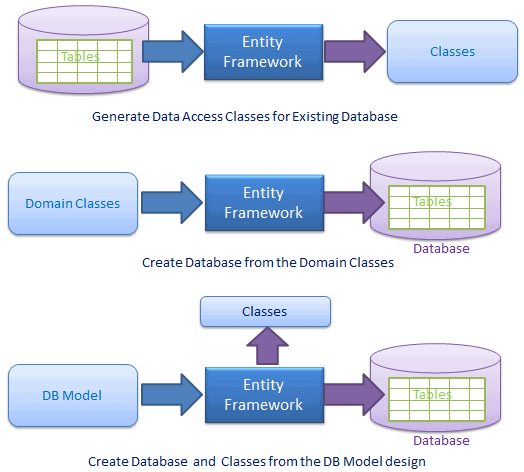Entity Framework Tutorial Basics(2):What is Entity Framework?
What is Entity Framework?
Writing and managing ADO.Net code for data access is a tedious and monotonous job. Microsoft has provided an O/RM framework called "Entity Framework" to automate database related activities for your application.
Microsoft has given the following definition of Entity Framework:
The Microsoft ADO.NET Entity Framework is an Object/Relational Mapping (ORM) framework that enables developers to work with relational data as domain-specific objects, eliminating the need for most of the data access plumbing code that developers usually need to write. Using the Entity Framework, developers issue queries using LINQ, then retrieve and manipulate data as strongly typed objects. The Entity Framework's ORM implementation provides services like change tracking, identity resolution, lazy loading, and query translation so that developers can focus on their application-specific business logic rather than the data access fundamentals.
Entity framework is an Object/Relational Mapping (O/RM) framework. It is an enhancement to ADO.NET that gives developers an automated mechanism for accessing & storing the data in the database.
Entity framework is useful in three scenarios. First, if you already have existing database or you want to design your database ahead of other parts of the application. Second, you want to focus on your domain classes and then create the database from your domain classes. Third, you want to design your database schema on the visual designer and then create the database and classes.
The following figure illustrates the above scenarios.

As per the above figure, EF creates data access classes for your existing database, so that you can use these classes to interact with the database instead of ADO.Net directly.
EF can also create the database from your domain classes, thus you can focus on your domain-driven design.
EF provides you a model designer where you can design your DB model and then EF creates database and classes based on your DB model.
What is O/RM?
ORM is a tool for storing data from domain objects to relational database like MS SQL Server, in an automated way, without much programming. O/RM includes three main parts: Domain class objects, Relational database objects and Mapping information on how domain objects map to relational database objects (tables, views & storedprocedures). ORM allows us to keep our database design separate from our domain class design. This makes the application maintainable and extendable. It also automates standard CRUD operation (Create, Read, Update & Delete) so that the developer doesn't need to write it manually.
A typical ORM tool generates classes for the database interaction for your application as shown below.

Visit wikipedia for more information on Object-relational Mapping
There are many ORM frameworks for .net in the market such as DataObjects.Net, NHibernate, OpenAccess, SubSonic etc. Entity Framework is an open source ORM framework from Microsoft.
Please note that Entity Framework is an open source framework by Microsoft. You can contribute to the Entity Framework project on codeplex.
Entity Framework Tutorial Basics(2):What is Entity Framework?的更多相关文章
- Entity Framework Tutorial Basics(20):Persistence in Entity Framework
Persistence in Entity Framework There are two scenarios when persisting an entity using EntityFramew ...
- Entity Framework Tutorial Basics(8):Types of Entity in Entity Framework
Types of Entity in Entity Framework: We created EDM for existing database in the previous section. A ...
- Entity Framework Tutorial Basics(25):Delete Single Entity
Delete Entity using DBContext in Disconnected Scenario: We used the Entry() method of DbContext to m ...
- Entity Framework Tutorial Basics(24):Update Single Entity
Update Existing Entity using DBContext in Disconnected Scenario: In this chapter, you will learn how ...
- Entity Framework Tutorial Basics(23):Add Single Entity
Add New Entity using DBContext in Disconnected Scenario: In this chapter you will learn how to add n ...
- Entity Framework Tutorial Basics(1):Introduction
以下系列文章为Entity Framework Turial Basics系列 http://www.entityframeworktutorial.net/EntityFramework5/enti ...
- Entity Framework Tutorial Basics(31):Migration from EF 4.X
Migration from Entity Framework 4.1/4.3 to Entity Framework 5.0/6.0 To migrate your existing Entity ...
- Entity Framework Tutorial Basics(27):Update Entity Graph
Update Entity Graph using DbContext: Updating an entity graph in disconnected scenario is a complex ...
- Entity Framework Tutorial Basics(22):Disconnected Entities
Disconnected Entities: Before we see how to perform CRUD operation on disconnected entity graph, let ...
随机推荐
- golang的项目结构 相关知识
### 项目结构 ``` ├── bin │ ├── login │ └── main ├── pkg │ └── darwin_amd64 │ └── login │ └── a ...
- C++动多态和静多态
动多态的设计思想:对于相关的对象类型,确定它们之间的一个共同功能集,然后在基类中,把这些共同的功能声明为多个公共的虚函数接口.各个子类重写这些虚函数,以完成具体的功能.客户端的代码(操作函数)通过指向 ...
- grafana 4.0.2 + openfalcon query 1.4.3
转:http://blog.csdn.net/vbaspdelphi/article/details/53884282 grafana 4.0.2 加上官方app自带的openfalcon插件, 可以 ...
- Azure VNet介绍
Azure VNet的介绍 VNet是Azure云中逻辑隔离的虚拟网络.它包含两个含义: Azure的用户可以在VNet中创建自己的各种资源,感觉想自己的数据中心中一样; 在一个VNet中创建的资源和 ...
- Jetty + Servlet 实现文件下载
Jetty非常适合做嵌入式web开发,正如Jetty的口号"Don’t deploy your application in Jetty, deploy Jetty in your appl ...
- Django基础(三)
Template 不能直接将html硬编码到视图里的原因: 对页面设计进行的任何改变都必须对python 代码进行相应的修改.站点设计的修改往往比底层python 代码的修改要频繁的多,因此如果可以在 ...
- ManualResetEvent 用法
第一.简单介绍 ManualResetEvent 允许线程通过发信号互相通信.通常,此通信涉及一个线程在其他线程进行之前必须完成的任务.当一个线程开始一个活动(此活动必须完成后,其他线程才能开始)时, ...
- 2016.2.13 (年初六) oracle两张表update方法
A表customers和B表tmp_cust_city有3个相同字段, customer_id,city_name,customer_type 现要根据b表更新a表 更新一个字段情况: update ...
- windows服务编写和“以管理员运行”程序的方法
本文将首先解释如何 创建 一个定期查询可用物理内存并将结果写入某个文本文件的服务.然后指导你完成生成,安装和实现服务的整个过程. 第一步:主函数和全局定义 首先,包含所需的头文件.例子要调用 Win3 ...
- Changing Controller Numbers in Solaris
If you need to change the controller numbers (c#) that a disk has assigned to it, whether it is for ...
